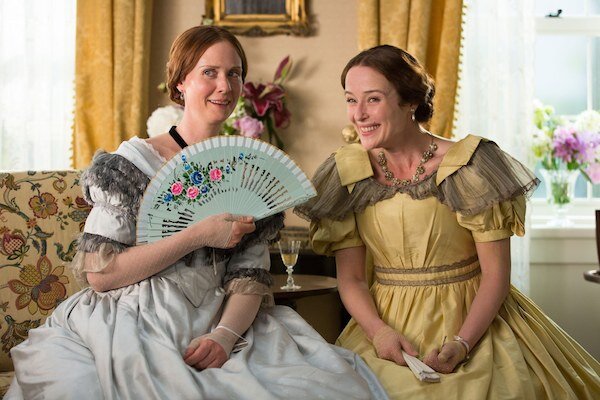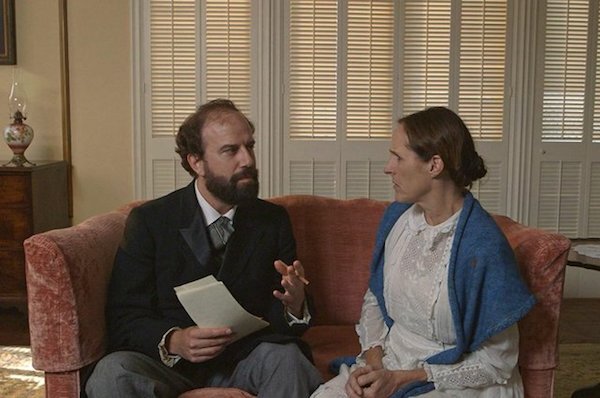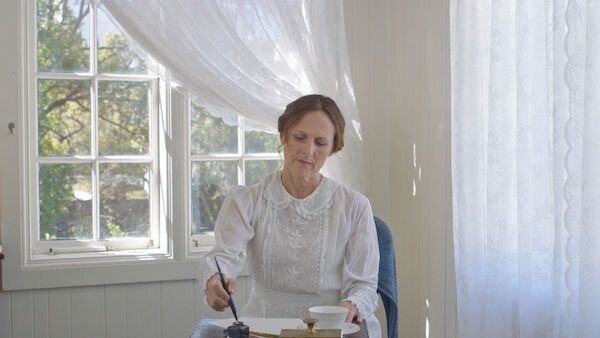In the 19th century, Emily Dickinson wrote some of the finest poetry we have today – but it took years for the world to catch up. On screen, her story hasn’t always been told properly. Orla Smith dissects what it took to finally give Dickinson the art she deserves.
I first saw Wild Nights with Emily at the 2018 Edinburgh Film Festival, on a whim. I slumped down into the screening room to see yet another film about 19th century poet Emily Dickinson, only a year after Terence Davies’ A Quiet Passion had thoroughly bored me. But over the next 90 minutes, Wild Nights director Madeleine Olnek revealed that I had been lied to: everything I had been told about Emily Dickinson throughout my life, and that had been reinforced in A Quiet Passion — that she was a spinster, a recluse, a crotchety old woman — was wrong. This Emily was stubborn and not easily pleased, yes, but she was also witty, loving, and adored by those lucky enough to be welcomed into her circle. More than that, she was in love with another woman.
Along with A Quiet Passion and the recent TV series Dickinson — which reimagines her youth as a frothy, poppy teen melodrama — Wild Nights is one of three recent screen renderings of the poet’s life. The question of ‘why now?’ seems simple enough: there’s a tangible appetite for women’s stories since the #MeToo scandal broke news of powerful Hollywood men harassing female creatives and damaging their careers and lives. This echoes neatly with Dickinson’s story of tragically hidden genius. She wrote hundreds of brilliant poems but saw only a handful of them published in her lifetime, because, well, the 1800s weren’t the best time to be a female writer.
Wild Nights With Emily is the film that Emily Dickinson deserves, true to her lively spirit and to her historically proven, but long denied, queerness. Like Dickinson’s writing, Olnek’s filmmaking is inspired, creative, witty, and lyrical. She chooses to focus on an older Emily in the years leading up to her death, placing particular emphasis on her relationship with lifelong lover Susan, who is married to Emily’s brother. Occasional flashbacks illustrate the beginning of their affair as younger women, but Olnek mostly trains her lens on the casual, loving familiarity of an older couple. Devised by reading and analysing Dickinson’s letters and poems, hundreds of which were published posthumously, Wild Nights with Emily roots its portrayal on thoroughly researched facts rather than the rumour mill that has surrounded her life since (and even before) she died.
Rather than glorifying the famous figure and her creative process, Olnek brings her down to earth. The film begins with Mabel Todd, the first posthumous publisher of Dickinson’s poems (who never actually met the poet herself), speaking to a crowd about the now-dead Emily. She paints her as an elusive and larger-than-life figure. This myth is quickly debunked as we cut to the real Emily years earlier, in the most mundane of settings: her home kitchen, baking gingerbread while messily scrawling lines of a poem on the back of the recipe. It’s immediately established that Emily is not the mysterious being Mabel describes her as, or that modern audiences believe her to be, nor was her writing process sacred or precious. She may be a genius, but she’s as inspired by the simple act of baking for local children as she is by the sublime wonders of the universe.
Above all else, Emily’s passion was ignited by her love affair with Susan. When Mabel Todd published Emily’s poems and letters, she erased every mention of Susan’s name, replacing it with the names of various men. Todd obscured Dickinson’s sexuality and suggested that she was a lonely spinster who pined after men, a more marketable narrative that made it easier for Dickinson’s work to reach a mainstream audience. However, Ellen Louise Hart and Martha Nell Smith’s 1998 book Open Me Carefully: Emily Dickinson’s Intimate Letters to Susan Huntington Dickinson published versions of Dickinson’s poems and letters restored to their original state, revealing them as love letters to Susan. Despite this, as a title card at the end of Wild Nights states, “Notions persist to this day of Emily Dickinson as a spinster old maid who was afraid to leave her room or publish her work” — a heterosexual spinster, to be precise. But Wild Nights suggests that Emily was, in fact, romantically and sexually fulfilled by Susan, who lived next door from their 20s until Emily’s death. They were able to share a domestic intimacy with one another, even in secret: When Emily shows Susan her poetry, Susan reacts with the joy of a proud partner and the sharpness of an incisive intellectual. They squabble over each others’ stubbornness and vices and jealousies, as all longtime couples do (at one point they don’t speak for weeks), but they always come back to each other.
Olnek dispels the myth that Dickinson was afraid to publish her work: Emily is eager to speak to potential publishers (all of whom are male), but she repeatedly fails to connect with them. In one particular scene, she nervously waits to meet publisher Thomas Wentworth Higginson, and upon his arrival speaks hurriedly, trying to convince him of her intellect. This anxiously awaited meeting of minds ends miserably when Higginson suggests to an aghast Emily that she re-edit her poems to make them more commercial, adding rhymes and titles. Another male visitor, Ralph Waldo Emerson, is an ageing man who frustrates Emily by falling asleep mid-conversation and constantly losing his train of thought. These are the men it was suggested that Emily was in love with. Susan was the best editor Emily had, but as a woman, she didn’t have the power or means to publish Emily’s work, and so it stayed between them.
Other cinematic renderings of Emily Dickinson’s life have tried and failed to honour her legacy to the standard of Wild Nights. Dickinson comes the closest, casting Hailee Steinfeld as a younger Emily as she attempts to publish her poems, learns her lover Susan is engaged to her brother, and has a brief affair with her father’s assistant, Ben Newton. However, Dickinson aestheticises Emily’s story for relevance and commercial appeal. The show has its heart in the right place, and Steinfeld succeeds in capturing Emily’s rebellious spirit and her wit. But the blatant pandering to a modern, youth audience feels condescending: the show uses a modern dialect and soundtrack, as well as other randomly placed anachronistic detail, in a story still set in the 1800s. There are sex scenes to Mitski songs, and Emily dances around her bedroom to Lizzo. The commercialisation of Dickinson’s story is at odds with the work of the woman herself, who refused the marketing move of titling her poems because it compromised their artistic ambiguity.
Dickinson, although artistically flawed, is ultimately a positive cultural object, providing teens with a prodigious, bisexual role model; A Quiet Passion is both needlessly dour and arguably harmful in its erasure of Dickinson’s queerness. Director Terence Davies feeds into common misconceptions about Dickinson’s life that Wild Nights later worked so hard to debunk. It’s a product of a poorly researched film, as Davies admitted he “didn’t have time to read [Dickinson’s published] letters,” which provide crucial insight into who she was as a person. The film’s ultimate crime is that it altogether omits Emily’s and Susan’s romantic relationship; re-painting it as merely a platonic friendship and instead chooses to focus on Dickinson pining for men.
Davies’ lack of interest in Dickinson’s real life and psyche suggests he was more interested in using this historical figure as a blank canvas on which to project his own anxieties. In the years leading up to making A Quiet Passion, Davies says he wrote a lot of poetry. In Geoffrey Macnab’s Independent interview, he expressed a strong identification with Dickinson:
“I am too afraid, I am too conventional. If anyone writes my biography, it will be a leaflet rather than a book. I don’t do anything. I don’t take drugs or anything. It is really a boring life! … For 10 years, people weren’t interested in my work. I do know what that is like and it is a horrible feeling. It’s like, I’ve poured my life into my work and what for… for three people and a dog to see my film.”
Understandably, Davies saw himself in conventional tellings of Dickinson’s story, those that focus on her loneliness, her isolation, her lack of recognition, and her lack of purpose outside of her work. But in this process of under-researched self-reflection, he spread harmful myths about Dickinson, particularly in erasing her sexuality. While some may argue that a filmmaker has the right to take creative licence with a true story, there is real collateral damage in imposing heterosexuality on one of pre 20th-century history’s few known queer icons. Especially if you’re making the first ever theatrically released film about that icon.
Rachel Handler’s Vulture exposé on the animosity between the creative teams of Wild Nights and A Quiet Passion makes Olnek’s and historian Martha Nell Smith’s feelings on Davies’ film clear:
“We lose her humanity, not understanding how she worked, how she lived her life. Emily Dickinson did not die miserable and alone as Terence Davies would have you think,” says Olnek. “She lived on her own terms, which is different than living ‘crazy.’” “Davies’s fixed idea about Emily is that she was writing out of lack,” says Smith. “The record shows that she was writing out of abundance.”
Davies may find the idea of the tortured, reclusive artist romantic and cinematic, but this should not come at the expense of Dickinson’s memory. Olnek goes against Davies’ directorial choices in a multitude of ways: Wild Nights is bright and colourful; A Quiet Passion is submerged in shadows. The former Emily loves passionately; the latter yearns quietly. Both end on a note of sadness and rage that Dickinson died before receiving recognition, but the impact is felt so much deeper in Wild Nights because we have witnessed the vibrancy of the woman being mourned. Wild Nights presents the reality of Emily Dickinson: a witty, visionary woman who chose her company carefully and thrived in that company; a woman in love; a woman who was done a disservice by the literary world, but who still found much to live for.
Orla Smith (@orlamango) is a freelance writer based near London, she is also the Executive Editor of Seventh Row.






